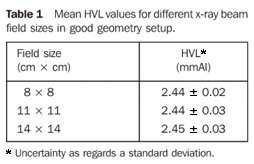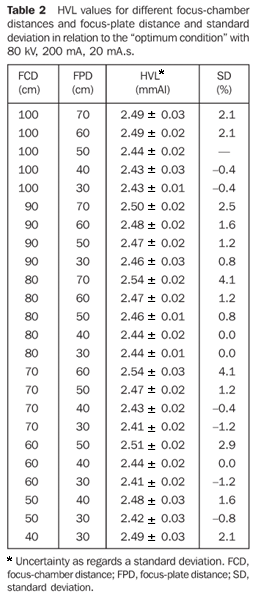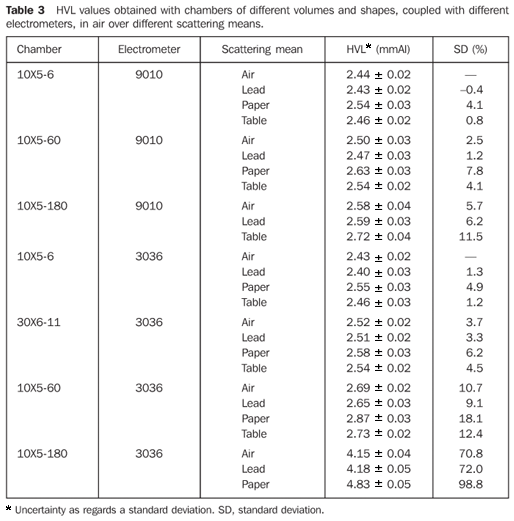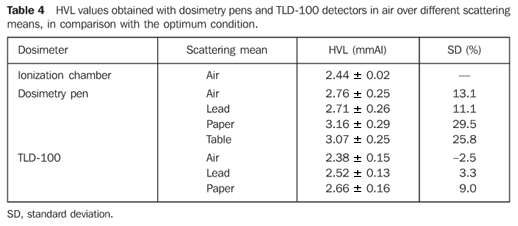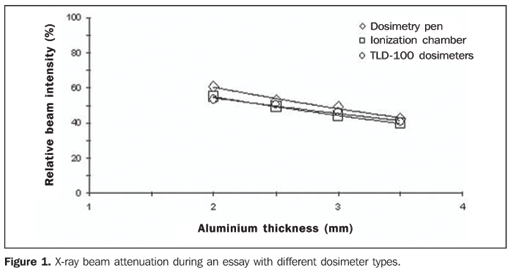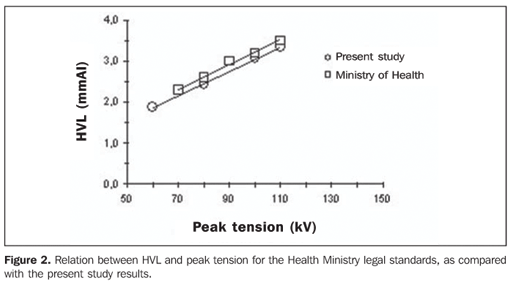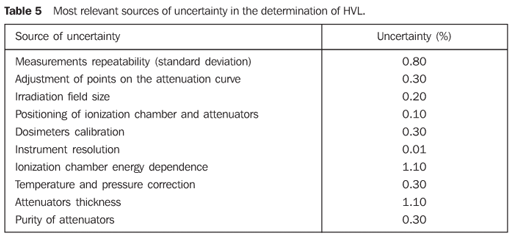Radiologia Brasileira - Publicação Científica Oficial do Colégio Brasileiro de Radiologia
AMB - Associação Médica Brasileira CNA - Comissão Nacional de Acreditação
 Vol. 40 nº 5 - Sep. / Oct. of 2007
Vol. 40 nº 5 - Sep. / Oct. of 2007
|
ORIGINAL ARTICLE
|
|
The methodology for evaluating half-value layer and its influence on the diagnostic radiology |
|
|
Autho(rs): Marco Aurélio de Sousa Lacerda, Teógenes Augusto da Silva, Arno Heeren de Oliveira |
|
|
Keywords: Half value layer, HVL, Quality control, Diagnostic radiology |
|
|
Abstract:
IPhD in Nuclear Sciences, Research Assistant at Centro de Desenvolvimento da Tecnologia Nuclear/Comissão Nacional de Energia Nuclear (CDTN/CNEN), Belo Horizonte, MG, Brazil
INTRODUCTION The filtration of the radiation beam produced by a x-ray tube reduces the patient radiation exposure, since this procedure preferentially removes low energy photons unnecessary for the formation of the diagnostic image of interest. The International Commission on Radiological Protection (ICRP) has established a minimum value for the total filtration thickness to be adopted with diagnostic x-ray beams; such value should not be lower than 2.5 mmAl (except for mammography equipment), and equal to 1.5 mmAl for odontological x-ray up to 70 kV(1). X-ray equipment manufacturers must ensure that the ICRP minimum filtration requirements are met. Most frequently, the method employed to infer about the total filtration of an equipment associates the total filtration with the quality of the x-ray beam, also denominated penetrability or penetrating energy, numerically characterized by the half-value layer (HVL). Several authors present correlations between HVL for a determined potential and the total filtration of the tube, also denominated quality diagrams(2,3). Considering the great discrepancies among these diagrams because of the several parameters influencing the correlation between HVL and total filtration, the Brazilian standards(4), as well as the majority of technical standards in other countries establish only minimum HVL values for certain tube tensions (kV) and number of phases supply the generator. If such minimum values are obtained for HVL, it is assumed that the total beam filtration is in compliance with the ICRP standards. The HVL may be more completely defined as the absorber material thickness necessary to reduce the x-ray beam intensity to half its incident magnitude, under good geometry conditions. This condition implies a configuration that minimizes the scattering influence which tends to increase the HVL value. Farr(5) and Trout et al.(6) have studied the effects of variations in the radiation field size and focus-filter-detector distances on HVL measurements. Trout et al.(6) have developed a method for accurately determining the HVL for energies generated by 100-300 kV tensions, based on the extrapolation to size of the null field in the HVL curve as a function of size of the radiation field incident on the filter. Besides geometry, other uncertainty sources, particularly those resulting from the dosimetry and analysis of beam attenuation data, affect the HVL measurement(3,6-8). Technical, practical and economic factors should be always taken into consideration when a methodology is adopted; however, its reliability depends on the establishment of all the relevant uncertainty components obtained by means of a detailed analysis of parameters directly influencing such measurements. In the present study, a critical analysis is performed on the methodology for measurement of HVL in diagnostic x-ray beams, according to technical standards established by the Brazilian Ministry of Health(4). Relevant parameters for HVL measurement and main uncertainty components are identified to assure compliance of the analyzed equipment with the performance standards.
MATERIALS AND METHODS The experimental study was developed with a VMI, Pulsar 800 Plus model x-ray diagnostic unit with high frequency generator, 16º angle rotating tungsten anode, double focus (FF = 1.0 mm and FG = 2.0 mm). This equipment presents a linear air-kerma rate with current and load, respectively, < 0.01 and < 0.02, accuracy and tension reproducibility, and exposure time < 2.5%, reproducibility of air-kerma rate < 2%, and yielding = (3.86 ± 0.08) × 10-2 mGy/mA.s, at 80 kV and 1 m. The choice of a methodology for HVL measurement involved the evaluation of the radiographic technique, experimental arrangement, attenuators, measurement instrumentation, radiation field size and procedure for analysis of beam attenuation data. As regards the choice of the radiographic technique, the American Association of Physicists in Medicine(9,10) recommends the utilization of a 80 kV tube potential, current between 200 mA and 400 mA, and exposure time > 50 ms. On the other hand, the Instituto de Eletrotécnica e Energia(11) recommends 80 kV tube potential and range of tube current x exposure time = 20 mA.s, suggesting a test with the air-kerma rate reproducibility to define which current provides the most reproducible values for a same parameter. So, the present study considered a radiographic technique with 80 kV voltage, load of 20 mA.s, and current of 200 mA. The attenuators consisted of commercial-type aluminium alloy 1200 H14, (minimum 99% aluminium) and maximum limits established by the NBR-7556(12). The conclusions of the study developed by Piubelli(13), who had performed comparative measurements of x-ray beam attenuation by standard high purity plates, and demonstrated a non-significant difference for the beam quality (< 0,1%), and the expensiveness of commercial high purity plates were the main reason for the choice of commercial aluminium. The aluminium plate thickness with respective tolerance declared by the manufacturer (Alcan) was 0.50 ± 0.04 mm, confirmed by measurements with a Mitutoyo MFG digital micrometer, performed on three sites of each plate, with 0.01 mm maximum deviation. In order to minimize the uncertainties caused by the experimental arrangement (geometry) and by the dosimetry of measurements considered as a reference, a Radcal/MDH 10X5-6 model, low volume (6 cm3) ionization chamber with low energy dependence (± 3% between 30 keV and 150 keV) attached to a Radcal/MDH 9010 model electrometer. Following the recommendation for a good geometry(6,9, 10,14,15), The chamber was placed at 100 cm from the focus, and at 30 cm from the scattering means; the aluminium plates were placed at 50 cm from the focus, corresponding to half the focus-chamber distance. The beam attenuation measurements were performed for three ranges of field sizes incident on the ionization chamber: one smaller (8 × 8 cm2), one intermediate (11 × 11 cm2), and another, larger (14 × 14 cm2), aiming at obtaining, by extrapolation, the value corresponding to the null field(6). The HVL was determined by means of the exponential adjustment of the four points of beam attenuation, near the correspondent to half the initial intensity; so, by not utilizing the initial measurement without the beam attenuation, the uncertainty resulting from the data interpolation and exponential beam attenuation was minimized(16). The geometry influence on the experimental arrangement for HVL determination was evaluated by means of measurements with different focus-plate (FPD) and focus-chamber distances (FCD), with other parameters remaining unchanged. Additionally, for evaluation of the dosimetry influence on the HVL, measurements were performed with different ionization chambers (both in shape and volume - 11 cm3, 60 cm3 and 180 cm3), attached to Radcal/MDH 3036 and 9010 model electrometers; measurements with two other types of detectors - dosimetry pens 862L model, and fluoride lithium thermoluminescent TLD-100 dosimeters (Harshaw/Bicron Chemical Company) - also were performed. The different chambers and detectors were placed in air, over 8 cm-lead cubes and 30 cm-paper sheet layers for analysis of the scattering means influence. The uncertainty components in the HVL determination were estimated according to the recommendations of Associação Brasileira de Normas Técnicas(17). For A-type uncertainty, the standard deviation for the three essays, and the standard deviation of the estimated HVL value in the adjustment were considered. For B-type uncertainty, the following factors were considered as uncertainty sources: energy dependence, resolution, temperature and pressure corrections, dosimeters positioning calibration and geometry, and aluminium plates thickness and purity. The quadratic combination of this uncertainty components resulted in a combined standard uncertainty which, multiplied by the coverage factor k = 2, supplying the expanded uncertainty. Aiming at evaluating the compliance of the equipment with the performance standards established by the Brazilian regulatory authorities(4), in a wider coverage range in terms of peak tension, HVL at 60 kV, 100 kV and 110 kV were determined. The same 20 mA.s and 200 mA radiographic parameters, Radcal/MDH 10X5-6 ionization chamber and geometry conditions of FCD = 100 cm and FPD = 50 cm employed for determining the optimum HVL value were utilized for this evaluation.
RESULTS HVL values for the 8 × 8 cm2, 11 × 11 cm2 and 14 × 14 cm2 radiation fields obtained with the 6 cm3 ionization chamber in good geometry, are shown on Table 1. The HVL values ranged between 2.44 mm and 2.45 mmAl, with uncertainties from 0.8% to 1.2% represented by the standard deviation.
The geometry influence on the HVL was evaluated by means of different combinations of FCD and FPD ranging between 30 cm and 100 cm. The HVL values found for the different combinations with the respective standard deviation are compared with the values found for the measurements in good geometry (Table 2). The maximum deviation was 4.1%.
The influence of the dosimetry procedure on the HVL measurement was evaluated with ionization chambers of different volumes, attached to electrometers and placed in air and over different scattering means (air, lead, paper, table). The mean values obtained for HVL, with respective standard deviation, are shown on Table 3. In the measurements with the 9010 electrometer, the HVL presented a deviation up to 7.8% in relation to the value in good geometry, in the presence of paper as a scattering mean. For the model 3036, the maximum deviation was 98.8% under the same conditions.
Table 4 shows the comparison between mean HVL values and respective standard deviations, when dosimetry pens and thermoluminescent dosimeter (TLD-100) are utilized in the presence of scattering means. The tables, also, present deviations in relation to the optimum condition, considered as the one with the 10X5-6 chamber placed in air, in standard geometry. The maximum deviation in the HVL value was 29.5% in the measurement with dosimetry pen, using paper as a scattering mean.
Figure 2 illustrates the HVL x peak tension relation for the minimum values established by the Brazilian Ministry of Health(4) in comparison with the values obtained in the present study, considering the most relevant uncertainty components in the HVL measurements, as well as the estimated and propagated HVL value (see Table 5). Therefore, the expanded HVL value uncertainty, considering k = 2, for an interval with 95% confidence level corresponds to 3.7%.
DISCUSSION HVL under good geometry conditions HVL measurements under good geometry conditions (Table 1) did not show any variation in values with the radiation field size, not evidencing the presumed trend of decrease in HVL for the null field reported by Trout et al.(6). Therefore, there is no need to perform measurements with several field sizes for determining HVL; an intermediate field size may be adopted, covering, with a small deviation to spare, the whole ionization chamber sensible volume. As regards the number of measurements, for practical reasons, one may perform only one measurement considering for each site the mean value of three shots of the equipment. Geometry influence on HVL The results from the analysis of the geometry influence on HVL (Table 2) have evidenced that, for a same FCD, HVL values tend to decrease as the FPD decreases in relation to the plate-chamber distance (PCD), with 4.1% maximum deviation for a maximum relation (PCD = 10 cm). In this case, the scattering influence on the HVL overestimation becomes evident. Table 2 also allows us to conclude that the HVL determination may be accurately achieved for a 50-100 cm FCD and a FPD/PCD ratio between 50% and 30%. This assumption for distances < 70 cm is contrary to Trout et al. recommendations(6) as well as the recommendations of the majority of the protocols evaluated in the present study(9,11,14). A possible explanation for this fact is that the classic study of Trout et al.(6), upon which the mentioned protocols are based, was developed for 250 kV x-rays (for therapy purposes), a value about three times higher than the one considered in the present essays (80 kV). That is to say, for this voltage range, the scattering influence tends to be smaller, and does not significantly affect the results. Another explanation would be the different features of generators and chambers utilized in the study of Trout et al.(6) and in the present study, a result from the technological development of the last four decades. Dosimetry influence on HVL The results from the analysis of dosimetry procedures influence on HVL values demonstrate that, for both electrometers, the HVL value increases proportionally to the ionization chambers volume, since sensitive scattering is shown to increase when higher volume ionization chambers are employed (Table 3). The significant difference of HVL values in measurements with ionization chambers with the same and higher volumes but connected to different electrometers, is explained by the influence of the greater electronic sophistication present in the 9010 model as compared with the 3036 model. It may be concluded that the association electrometer-ionization chamber volume affects significantly the HVL value determination, so the suggestion is that low-volume ionization chambers (to decrease the scattering influence) are always utilized in conjunction with appropriate electrometers to reduce errors, particularly those resulting from noise. The scattering material influence was analyzed with the results included on Table 3. it is observed that lead reduced the HVL value when placed below chambers 10X5-6, 10X5-60 and 30X6-11, demonstrating a decrease in the scattered radiation detected by the dosimeter. This may be explained by the high atomic number of lead which, for the studied voltage, favors the supremacy of the photoelectrical effect over the Comptom scattering, reducing the amount of scattered radiation on the detector. The results also demonstrate an increase in the HVL values with the ionization chambers positioned on paper layers, which also demonstrates the scattering influence on the HVL overestimation. Additionally, it may be observed that this increase becomes more significant when higher volume ionization chambers are utilized, considering their higher sensitivity. HVL values found with ionization chambers placed on examination tables demonstrated a small increase, sensibly lower than the one found with the same ionization chambers placed on paper layers. This demonstrates the scattering mean influence on the amount of scattered radiation detected. In summary, it may be concluded that: a) the utilization of lead cubes below the ionization chamber represents an excellent alternative to reduce the scattering influence on the HVL determination; b) a low-volume ionization chamber (< 6 cm3) placed on the examination table or on the same lead cubes may yield reliable results for HVL determination. Table 4, also, shows that the values found for HVL utilizing dosimetry pens placed in air were higher than those found with the ionization chamber under the same conditions (optimum value). This is a result from the difference in the inclination of the beam attenuation curves (Figure 1) caused by the higher dosimetry pen energy dependence as compared with the ionization chamber. Also, it is observed that the results with the dosimetry pen and TLD- 100 detectors presented much higher uncertainties (standard deviation) than those found under "optimum conditions", caused both by the higher energy dependence of these detectors and the low resolution of the dosimetry pen. One may conclude that dosimetry pens should not be utilized for determining HVL because of the high uncertainty rates in measured values resulting particularly from the high energy dependence. Also, the utilization of TLD-100 detectors is not recommended for determining HVL, considering: a) the uncertainty magnitude resulting from the high sensitivity of these dosimeters to high temperatures, handling and chemical contamination; b) higher energy dependence; c) practical and economic difficulties. Compliance of HVL values The comparison between HVL values obtained in the present study and minimum value established by the Ministry of Health(4) (Figure 2) has shown that, for all of the analyzed voltage ranges, HVL values are about 7% higher than those, demonstrating that the x-ray diagnostic unit utilized is not in compliance with the performance standards established by the regulatory authority, even if the uncertainty of about 4% found for the HVL value is considered. The present study has evidenced that the dosimeters energy dependence, the attenuators thickness, and the repeatability of measurements were the uncertainty sources which have most contributed to the uncertainty in the HVL measurement.
CONCLUSIONS The present study has demonstrated the feasibility of a practical procedure for determining HVL in diagnostic radiology, highlighting the utilization of a low-volume, low energy dependent ionization chamber and an optimum geometry condition to reduce the influence of scattered radiation. The results of HVL measurements have testified to the metrological reliability of the practical procedure, showing, also, the remarkable discrepancies resulting from the adoption of inappropriate methodologies and affirming the need for definition of the main influential parameters as well as the establishment of a standard procedure. It is considered that the critical analysis of the HVL test as part of the program for radiodiagnosis quality control was accomplished in detail, guaranteeing the results reliability and confidence to certify the compliance or non-compliance of the x-ray unit with legal requirements. Something similar should be done in relation to all the other tests in the quality program(4) aiming at the standardization of procedures as a contribution to the adoption of appropriate performance standards according to the Brazilian reality.
REFERENCES 1.International Commission on Radiological Protection. Protection of the patient in diagnostic radiology. ICRP Publication 34. New York, NY: Pergamon Press, 1982. [ ] 2.Trout ED, Kelley JP, Furno EJ. A study of the inherent filtration of diagnostic X-ray tubes. Radiology 1956;66:102–106. [ ] 3.Nagel HD. Limitations in the determination of total filtration of x-ray tube assemblies. Phys Med Biol 1988;33:271–289. [ ] 4.Ministério da Saúde. Diretrizes de proteção radiológica em radiodiagnóstico médico e odontológico. Portaria nº 453. Diário Oficial da União, 2 de junho de 1998. [ ] 5.Farr RF. The specification of roentgen ray output and quality. Acta Radiol 1955;43:152–160. [ ] 6.Trout ED, Kelley JP, Lucas AC. Determination of half-value layer. Am J Roentgenol Radium Ther Nucl Med 1960;84:729–740. [ ] 7.Wagner LK, Archer BR., Cerra F. On the measurement of half-value layer in film-screen mammography. Med Phys 1990;17:989–997. [ ] 8.Sunde PB. Specification and selection of dosimetry instrumentation for diagnostic radiology. Radiat Prot Dosim 1992;43:183–186. [ ] 9.American Association of Physicists in Medicine. Performance acceptance testing for X-ray generators and automatic exposure control devices. AAPM Report 14. New York, NY: American Institute of Physics, 1985. [ ] 10.American Association of Physicists in Medicine. Protocols for the radiation safety surveys of diagnostic radiological equipment. AAPM Report 25. New York, NY: American Institute of Physics, 1988. [ ] 11.Instituto de Eletrotécnica e Energia. Procedimentos para testes de estado: equipamentos de raios X. IEE. São Paulo: Universidade de São Paulo, 1999. [ ] 12.Associação Brasileira de Normas Técnicas. Chapas de alumínio e suas ligas – especificação. NBR 7556. Rio de Janeiro, RJ: Associação Brasileira de Normas Técnicas, 2000. [ ] 13.Piubelli SL. Influência da pureza de absorvedores comerciais na determinação da energia efetiva e da camada semi-redutora para feixes de 24 a 50 kV, e propagação do erro para a taxa de exposição. (Dissertação de Mestrado). Rio de Janeiro, RJ: Universidade Federal Fluminense, 1989. [ ] 14.Instituto de Radioproteção e Dosimetria. Controle de qualidade em radiodiagnóstico. Protocolos IRD. Rio de Janeiro, RJ: Instituto de Radioproteção e Dosimetria, 2000. [ ] 15.International Commission on Radiation Units and Measurements. Recommendations of the International Commission on Radiation Units and Measurements. Physical Aspects of Irradiation. Report 10b, 1962. [ ] 16.Lacerda MAS. Análise crítica da medida da camada semi-redutora em radiologia diagnóstica. (Dissertação de Mestrado). Belo Horizonte, MG: Universidade Federal de Minas Gerais, 2002. [ ] 17.Associação Brasileira de Normas Técnicas. Guia para expressão da incerteza de medição. 2ª ed. Rio de Janeiro: Associação Brasileira de Normas Técnicas, Inmetro, 1998. [ ]
Received December 22, 2006. Accepted after revision February 13, 2007.
* Study developed at Centro de Desenvolvimento da Tecnologia Nuclear/Comissão Nacional de Energia Nuclear (CDTN/CNEN), Belo Horizonte, MG, Brazil. |
|
Av. Paulista, 37 - 7° andar - Conj. 71 - CEP 01311-902 - São Paulo - SP - Brazil - Phone: (11) 3372-4544 - Fax: (11) 3372-4554
